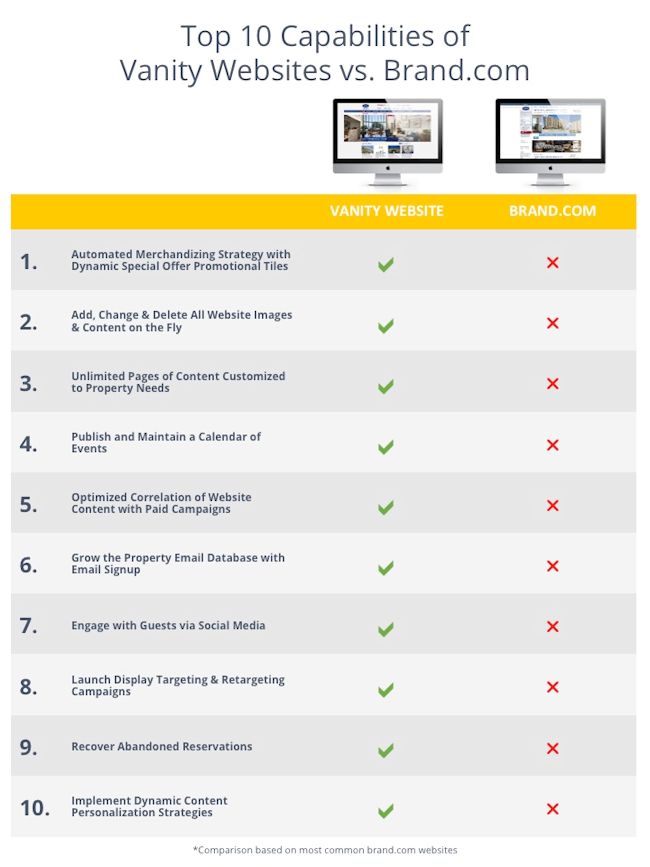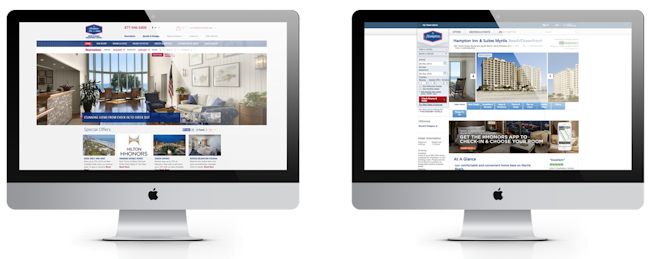By Sara O’Brien & Ryan DeJong
Branded hotels are in a unique digital marketing predicament. On the one hand the brand is a marketing organization and can open doors and steer demand to the branded hotel that is far out of the reach of any independent hotel. The investment in a brand affiliation provides the competitive benefit of attracting national and global travelers, brand-loyal guests, and Fortune 500 business travelers. Yet with all the good intentions of the brand, tremendous revenue opportunities still exist for any branded property above and beyond the core focus of the major brand.
The branded hotel faces fierce competition from savvy independent properties in their market and properties from other major brands. But that is not all. Increasingly important is finding ways to differentiate from and compete against other branded properties from the same brand on brand.com, search engine results pages and online media. For example in New York City, a Marriott-branded property competes with 125 other Marriott-branded properties, while a Hilton-related property competes with 51 other Hilton-related properties. In Chicago, there are 80 Marriott-related properties and 66 Hilton-related properties.
So how can a branded hotel level the playing field and compete successfully against independents and other branded properties?
By implementing a property-level strategy focused on generating incremental revenues, targeting key market segments and engaging travel consumers above and beyond what the major brand can do for the property, consisting of:
- Launching a vanity website with editorial level, SEO-rich content with descriptions about the property’s products, services and customer segments.
- Launching a digital marketing action plan that supplements the brand’s efforts with property-level, local and niche initiatives.
In doing so, you will differentiate yourself within the brand, generate incremental revenues in addition to what the brand can provide, address lucrative local market segments, and further limit your exposure and reliance on the OTA channel.
The Vanity Website: The Gateway to Driving Incremental Revenues
Today’s hotel website serves two purposes: to sell rooms and engage users. It is the heart of the property’s direct online channel marketing initiatives, the main hub of the property’s multi-channel marketing campaigns across the three screens, and is the property’s main engagement platform with the always-connected online travel consumer.
The vanity website provides the branded hotel with the only real opportunity to generate incremental revenues today, outside of the major brand website and the OTAs.
Our extensive experience with branded hotels categorically shows that the vanity website equips the property with significant competitive advantages compared to branded hotels relying solely on the brand efforts. The branded hotel with a vanity website:
- Competes successfully against independent properties in the destination.
- Stands out and better competes with other branded properties, including properties from the same major brand.
- Increases direct online bookings and decreases reliance on the OTAs by significantly improving the merchandising capabilities of the property: generating on the fly relevant marketing landing pages, special offers and packages pages, events and happenings at the property and around the property.
- Improves search engine ranking share by adding 30-50 relevant content pages with property descriptions via the property vanity website, a nice improvement over the 5-10 pages of data-driven, dry content about the property on the major brand website.
- Gains market share from the comp set.
In the past, we have seen clear examples of the power of the vanity website: When new owners discontinued the property vanity website due to ill-conceived “savings” considerations, over 75% of the roomnights booked previously via the vanity website were lost to the competition, both branded and independents.
Vanity websites are by far the most cost-effective distribution channel and provide hoteliers with excellent ROIs, immediate results, and long-term competitive advantages. An analysis by HeBS Digital showed that on average the cost per booking via the OTAs is several times higher than via the property’s own vanity website.
What Can the Vanity Website Help the Branded Property Achieve?
BOOST IN ORGANIC SEARCH ENGINE REVENUES
A typical vanity website provides 30 – 50 pages of editorial-level, SEO-rich content and descriptions about the property’s product and services, customer segments and more. When compared to the 5-10 pages of dry, database driven content about the property on brand.com sites, it is clear how the vanity website will set the stage for direct online channel success. Take a look at Hampton Inn Myrtle Beach’s 30 pages of content on their vanity site, compared to 9 pages on their brand.com site.
A vanity website allows the property to focus content driven campaigns on everything the brand is not. Optimizing non-branded keywords, the property can target key market segments such as:
- Small & Mid-Size Corporate Meetings
- In-State & Regional Corporate Meetings
- Convention Attendees
- SMERF (Social, Military, Educational, Religious, Fraternal)
- Leisure Travelers
- Weekend Travel
- Family Travel
- Romantic Travel
- Special Occasions (Wedding Parties, Birthdays, Etc.)
- Senior Citizens
- Event-Based Travelers (Sporting Events, Festivals, Fairs, Etc.)
A vanity website allows the property to engage in property-specific and property-focused display targeting and retargeting campaigns, Dynamic Rate Marketing, and more, which are impossible without a vanity website.
MERCHANDISING STRATEGY WITH AD-HOC PROMOTIONS
With the right balance of excellent design and technology, the vanity website will enable a robust merchandising strategy to convert lookers to bookers and generate incremental bookings. An enhanced merchandising functionality allows the property to feature promotional opening slides, marketing messages intermingled with rich imagery, featured specials promo tiles on the home page, and more. Through a special offers module, the busy hotelier can schedule special offers for future start and end dates to keep the website up-to-date with frequent, relevant and timely offers. A Dynamic Content Personalization module takes the merchandising strategy to the next level by allowing the property to serve different promotions to users based on geo-location, demographics, and key customer segments.
Utilizing interactive marketing applications such as Limited Time Offers (LTOs) to kick start a slow season or monetize Cyber Monday, or interactive sweepstakes applications to generate buzz around the property and engage potential customers are all part of the merchandising strategy of the property above and beyond the efforts of the major brand.
PERSONALIZATION
A vanity website allows the property to engage in dynamic content personalization and target important feeder markets and customer segments, especially the leisure market. The more relevant content you deliver to the website visitor, the better the engagement and the higher the conversions and revenues. The more your website can resonate with user preferences and purchasing behavior, the higher the conversions you’ll see on the website.
Delivering unique and relevant textual, visual and promotional content to site visitors based on their demographics, location, website pathing behavior, or affiliation to a particular customer segment (leisure travel, family travel planner, meeting planner, SMERF group planner, wedding planner, social event planner, etc.) is one of the major advantages a vanity website provides the branded hotel.
HeBS Digital’s experience with hotel client websites as well as case studies from other companies shows that personalizing content, promotions and user experiences on websites results in uplifts in E-commerce sales as high as 40 percent!

DIGITAL MARKETING ABOVE-AND-BEYOND THE BRAND
Branded properties can easily make the fatal mistake of assuming that all their digital marketing is covered by the brands. Brands do provide value in certain areas of marketing such as national-level advertising, international brand exposure and large corporate meetings. However, the brand does not have the bandwidth to cover the marketing for the property-level and local niche initiatives. Therefore, the onus falls on the property for leisure travel marketing.
How can you implement digital marketing that will not compete with or cannibalize the efforts of the brand?
The branded property’s digital marketing efforts should focus on:
- Targeting key customer segments as mentioned above (leisure, weekend, small meetings & events, SMERFs, etc.)
- Utilizing long tail, property-specific keywords in SEO, SEM (paid search)
- Utilizing property-specific online media formats and initiatives that are not used by the brand for property-specific targeting, such as: retargeting via GDN, new Google advertising formats such as Remarketing Lists for Search Ads (RLSA) and Google Sponsored Promotions (GSP), highly targeted campaigns to in-market and first party data audiences, dynamic rate marketing on top travel ad networks, etc.
- Launching multi-channel campaigns to drive bookings during slow seasons with property-specific campaigns
For example, if you are a Chicago hotel, the brand may be bidding on or utilizing keywords such as “Chicago Downtown Hotel.” However, the property can bid on even more targeted keywords such as, “Chicago hotel with rooftop bar.” One HeBS Digital branded property client generated a return of 852% for the SEM / Paid search campaigns in 2014.
Implementing more focused, conversational keywords in your SEO strategy is not only important for branded properties; it is essential in achieving higher search engine rankings as a result of Google’s Hummingbird update.
Targeting midsize and smaller corporate groups and SMERFs, as well as social and special events, are one of the main reasons any branded hotel needs a property-level digital group strategy above and beyond the major brand. From rich visual and promotional content on the vanity website addressing these important customer segments, to interactive marketing applications and sweepstakes and laser-focused digital marketing campaigns (SEO, SEM, online media, social media, email marketing, mobile marketing), the opportunities for incremental group revenues and leads are endless.
A recent Meeting Planner Sweepstakes for a branded hotel in California successfully targeted meeting planners and drove significant traffic to the Meetings section of the vanity website, generated hundreds of views of the meeting planner video, and resulted in 130 RFP leads.
Lastly, launching multichannel marketing campaigns are the most effective way to address concrete business needs, increase reach, and boost bookings and revenue for the slow season or need period. The brand’s digital marketing campaign typically run consistently throughout the year, and do not account for these types of need periods. By supplementing the brand campaigns with an appropriately timed multi-channel campaign, the property will easily bolster revenues during an otherwise traditional low period.
Conclusion:
For the branded hotel, the main objective of the vanity website is to generate incremental revenues to what the brand.com provides. If all of this is taken into account, under the right conditions and with the proper digital marketing strategy, a vanity property website may reap significant rewards for the branded hotel. Many of our branded hotel clients have enjoyed significant online revenues from their vanity websites. If developed as per industry’s best practices, the branded hotel’s vanity website would complement nicely the efforts of the major brand and generate up to 75% of incremental bookings and group leads above and beyond what the major brand generates for the property.


